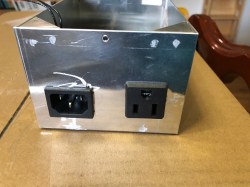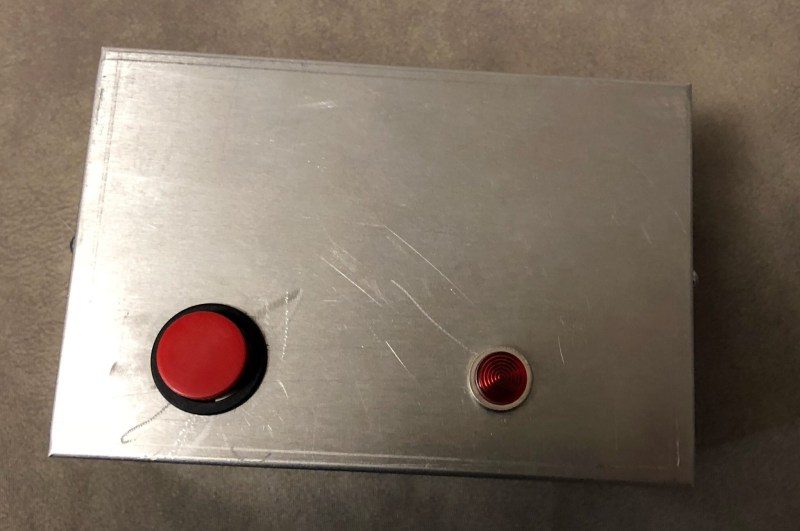As with the age-old panic after realizing you have left an oven on, a cand le lit, and so on, a soldering tool left on is a potentially serious hazard. Hackaday.io user [Nick Sayer] had gotten used to his Hakko soldering iron’s auto shut-off and missed that feature on his de-soldering gun of the same make. So, what was he to do but nip that problem in the bud?
le lit, and so on, a soldering tool left on is a potentially serious hazard. Hackaday.io user [Nick Sayer] had gotten used to his Hakko soldering iron’s auto shut-off and missed that feature on his de-soldering gun of the same make. So, what was he to do but nip that problem in the bud?
Instead of modding the tool itself, he built an AC plug that will shut itself off after a half hour. Inside a metal project box — grounded, of course — an ATtiny85 is connected to a button, an opto-isolated TRIAC AC power switch, and a ‘pilot’ light indicating power. After a half hour, the ATtiny triggers the opto-isolator and turns off the outlet, so [Sayer] must push the button if he wants to keep working. He notes you can quickly double-tap the button for a simple timer reset.
 [Sayer] had an issue where the power light would glow faintly with nothing plugged into the box — about 60V worth due to leaking from the TRIAC — which he circumvented with a well-placed resistor. If he had to start over, he says he wouldn’t mind adding a fuse and wider traces for extra insurance. If he plans on soldering for that hole half-hour, [Sayer] is going to need a serious fume extractor.
[Sayer] had an issue where the power light would glow faintly with nothing plugged into the box — about 60V worth due to leaking from the TRIAC — which he circumvented with a well-placed resistor. If he had to start over, he says he wouldn’t mind adding a fuse and wider traces for extra insurance. If he plans on soldering for that hole half-hour, [Sayer] is going to need a serious fume extractor.
















Could’ve been done with stick of Gum a 555 timer one Victorinox Swiss Army Knife and 80’s theme music.
I was thinking esp8266, etc so you could check on its status with your browser.
Oh, sure. One of the first comments I got on Twitter was “why not just a 555?”
The answer is that I have a ton of tiny85s laying around and no 555s, and I’m a software/firmware guy anyway.
Grounding means nothing when sockets are cat II (unearthed).
In this case, the inlet is an IEC C14 and the outlet is a NEMA 5-15, and the inlet is a 3 wire port plugged into a grounded outlet.
I see third prongs.
its a metal case. even if it had no outlets it needs grounded
Third prong on both inlet and outlet is for ground. It is connected to ground somewhere unless someone cheated and used non-grounded power cord or ripped the 3rd prong off the plug end.
Take the timer switch out of my old toaster oven that is now for rework , nahh ,
I have couple of those. Added bonus, a bell blings when power goes out.
Sorry, microwave, not toaster.
If Attiny was used, he can blink with “pilot light” led few times as warning before shuting down.
I went with an AC powered pilot light as the *ultimate* indicator of whether there was actually power present or not. Blinking the actual power would be possible, but potentially damaging to whatever is plugged in.
But, yeah, if I had hooked up an LED to one of the other pins, I could have made it into a “warning” indicator.
You could wire a NC relay in series with the light and at least turn it off with the ATTiny.
If it’s intended as a safety device, 30 mins seems a very long time to leave a hot thing unattended. 5 mins could easily be enough to start a fire – and would be a fairly long time to be desoldering, I’d think?
From a safety perspective, “getting used to” the auto-shut-off seems like a very bad idea. You shouldn’t be relying on safety features like that on a regular basis – they’re not safety features if you do so, as there’s no redundancy any more should the feature fail.
Inductive stand/holster timed , like a hot air station.
I don’t use the auto-shut-off as the way to turn it off. I really do turn it off when I’m done. I haven’t yet been careless with the desoldering tool (not so with the iron – it HAS had to turn itself off on occasion), but I just feel like human nature being what it is, it’d be good to have the tool have my back since it’s silent when it’s turned on (and the vacuum pump isn’t being run).
5 minutes would drive me bonkers, as it’s about 5 minutes to warm the tool up. And a half hour for me isn’t unheard of. I retrofit clock movements for my Tindie store, and a half hour is just an order of 6 of them or so.
an other wat of doping this might be using a Sonoff switch, since it has most of the components already in the box. Since it’s wifi enabled, you could add pushover messaging to your smartphone when it’s about to switch off.
Then if someone beaches your security they could mess up your computers AND burn your house down
I fixed the issue in my workshop by connecting the outlet for my bench into the overhead lighting circuit. No when I shutdown the lights, everything is off.
I tried to pull that same stunt at work, and as it turns out, the overhead florescent lights in our plant are 220 (which takes us to a different discussion).
Relay?
Probably 277…
I copied something that someone at the Milwaukee Makerspace did. I took apart a junked microwave oven and printed a wall mount for the timer/keyboard, and wired it to a power outlet strip. I keep the soldering iron plugged into that strip. When I want to use the soldering iron, I punch in the time I think the job will take and hit “Cook”. It has a countdown timer so I know how much time is left and I can just hit the “add 1 minute” button to extend the time.
I think I may be wired differently as a hacker. I typically don’t take other things apart and repurpose them (the one big exception to that was my reflow oven), but rather design things like this from scratch. I do respect those who go the repurposing direction, though.
What’s a “hole half-hour”?
I’m going to go out on a limb and guess that the missing “w” is a typo.
No use. He can’t let it go because he’s “Typo negative.”
For those who have been reading from the beginning, there are certain constants here.
Typos, people who complain about typos and the occasional post simalar to one from several years prior.
To be honest I prefer the real leaded solder. I rarely bother to so much as open a window. It hasn’t killed me yet (:
[ not a fan of “health and safety” ]
Leaded vs unleaded has nothing to do with the fumes unless your soldering iron is hot enough to make the solder boil.
That’s not to say the fumes aren’t… less than great for you…
Possibly some form of Adult Entertainment?
There are off-the-shelf solutions to this. I use one for my hakko desoldering gun ( which has no switch).
My Touchsmart Indoor Plug-In Digital Timer, 26892 https://www.amazon.com/dp/B014SGCIR4/ref=cm_sw_r_cp_apa_6uhGAb1J2AYKR
Belkin Conserve Socket Energy Saving Outlet with Timer, F7C009q https://www.amazon.com/dp/B003P2UMS0/ref=cm_sw_r_cp_apa_TvhGAbWWZ54H3
Woods 50030WD Indoor Countdown Timer, 1-Outlet Grounded https://www.amazon.com/dp/B00FSQTSB8/ref=cm_sw_r_cp_apa_qxhGAbB5NTGDS
I have all three around my house for various applications.
Those aren’t bad.
I certainly can’t claim I came even close on cost. There are a couple that do come pretty close to the “one button UI.”
I didn’t check wattage specs. If anyone those can do 200W, then it probably would have served.
But then I wouldn’t have been written up here. ????
“But then I wouldn’t have been written up here. ????”
This. :)
Ok, but why use a microcontroller when a CD 4536 will suffice?
Look at page 46 for a schematic diagram
http://www.rsp-italy.it/Electronics/Magazines/Nuova%20Elettronica/_contents/Nuova%20Elettronica%20211.pdf
Because I have a pile of them and am a really, really good firmware programmer.
When managing a clothing store, I had a tailor that would always leave his iron on overnight.
So I bought a double gang metal box, an outlet, and a bathroom fan timer, and wired it with a heavy duty extension cord. Worked flawlessly.
I did something like this once to house an Aube sunrise/sunset switch for a low voltage lighting transformer that wasn’t hard-wired. I just recently got rid of it because we adopted HomeKit, which has the ability to schedule stuff by sunset/sunrise, and HomeKit relay switched outlets are pretty cheap.
But why a metal box? Plastic is probably cheaper and more available. And can’t rust.
But oh well, to each his own.
If any wires inside come loose I want it highly likely to create a ground fault. That will trigger the GFCI it’s plugged into.
Why would the wires come loose though? Nothing is moving inside.
Although I suppose some brute could rip the mains connector out trying to unplug the cable.
Are you such a brute?
It’s unlikely, sure. It’s just “belt and suspenders” thinking, which is always a really good idea when dealing with high voltage gear.